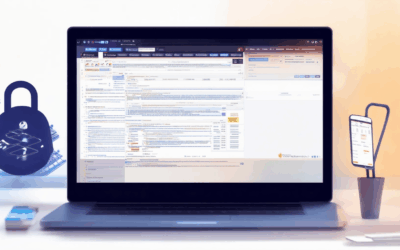In today’s digital age, managing your digital footprint has become crucial for individuals and businesses alike. As we move into 2024, the importance of understanding and strategically managing one’s digital footprint has never been more vital. Elevating your digital footprint management requires a proactive approach, blending effective strategies with actionable insights. From understanding the basics to exploring the complexities, this guide offers comprehensive strategies to help you navigate the ever-changing landscape of digital presence. By mastering digital footprint management, you not only protect your online reputation but also position yourself for long-term success in the digital world.
Key Takeaways
- Eliminate Social Media Traces: Delete profiles and associated data to reduce online presence.
- Secure Email Accounts: Export emails, change passwords, and enable two-factor authentication.
- Clear Search History: Use tools to remove activity from search engines comprehensively.
- Tidy Up Cloud Storage: Delete unnecessary files and encrypt those remaining.
- Remove Online Comments: Utilize platform features and contact forums for removal.
- Manage Public Information: Correct or remove personal data through official channels.
- Close Financial Accounts: Delete accounts and monitor credit reports for lingering data.
- Anonymize Browsing: Use VPNs and private modes to minimize new footprints.
- Track and Erase Data: Employ tools to locate and remove personal information.
- Adjust Privacy Settings: Limit data sharing on major platforms.
- Backup and Protect Data: Secure backups before deletion and encryption.
- Disappear from the Dark Web: Investigate services to remove personal info from dark web marketplaces.

What is a Digital Footprint in 2024?
A digital footprint refers to the collection of data trails left behind as individuals interact with online platforms, services, and technologies. In 2024, this concept has evolved significantly due to advancements in internet usage, increased reliance on digital services, and greater awareness of online privacy.
Key Components of a Digital Footprint in 2024
- Data Types :
- Information shared online, such as social media posts, comments, and interactions.
- Browsing history, including visited websites and search queries.
- Online transactions, purchases, and payment details.
- IP addresses and device identifiers used to access the internet.
- Creation Process :
- Every interaction on the internet contributes to building a digital footprint.
- Social media profiles, email communications, and even simple searches can leave traces.
- Implications :
- Personal information can be collected and analyzed by various entities, including corporations, governments, and cybercriminals.
- A positive digital footprint reflects transparency and trustworthiness, while a negative one may lead to privacy concerns.
Managing Your Digital Footprint
- Online Privacy Tools :
- Use encrypted communication platforms to protect sensitive information.
- Enable private browsing modes and delete unused accounts to minimize data exposure.
- Content Control :
- Be mindful of what you share online and avoid oversharing personal details.
- Regularly clean up old accounts and change passwords to reduce vulnerability.
- Digital Security :
- Implement strong passwords and enable two-factor authentication for accounts.
- Stay updated on cybersecurity trends to safeguard your online presence.
By understanding and managing your digital footprint, you can control how your online activities impact your privacy and reputation in 2024.
Understanding the 5 P’s of a Digital Footprint
A digital footprint refers to the collection of information that identifies an individual online. Here are the five key components:
- P – Personal Information: This includes any details that reveal your identity, such as your name, email address, phone number, or IP address.
- P – Privacy Practices: How you handle your personal information online, including password protection, account security settings, and data sharing habits.
- P – Participation: Online activities that contribute to your footprint, such as social media interactions, forum posts, or comments on articles.
- P – Promotion: Content you choose to share publicly, such as professional achievements, personal opinions, or creative work.
- P – Proof: The evidence of your online activities, which can be reviewed or accessed by others in the future.

Understanding and Managing Your Digital Footprint
Your digital footprint refers to the trail of information you leave behind as you navigate the internet. This includes everything from social media profiles to search engine results. Here’s how you can effectively manage your digital footprint:
1. Understand Your Online Presence
Start by conducting a simple online search for your name to identify what information is publicly available. This will give you insight into which platforms and data points contribute to your digital footprint.
2. Adjust Privacy Settings
Enhance your privacy by modifying your social media profiles. Make your profiles private, restrict access to your information, and enable two-factor authentication to secure your accounts.
3. Monitor for Unwanted Information
Utilize tools like the Internet Accountability Foundation to monitor your digital footprint. These tools can alert you if your personal information appears in places it shouldn’t.
4. Use Pseudonyms and Aliases
Consider using pseudonyms or nicknames online to protect your identity. However, be aware that real names may still surface through other channels like email addresses or educational institutions.
5. Exercise Caution with Personal Information
Before sharing information online, evaluate its necessity. Avoid oversharing details that could be misused or pieced together by others.
6. Delete Inactive Accounts
Regularly review and close accounts you no longer use. Deactivating unused social media profiles can reduce your digital footprint.
7. Regular Monitoring
Set up Google Alerts for your name to stay informed about new mentions or changes in your online presence. Act promptly if you spot unwanted content.
8. Contact Website Owners
If you find your information on unauthorized sites, contact the website owner using their provided contact methods. Many platforms have mechanisms for removing personal data.
9. Encrypt Sensitive Information
Use HTTPS websites and look for the padlock icon to ensure secure connections. While this protects data transmission, it doesn’t directly reduce your footprint but enhances security.
10. Stay Informed About Privacy Laws
Understand privacy laws like GDPR and CCPA to make informed decisions about your data. Knowledge empowers you to navigate the digital landscape effectively.
By following these steps, you can better control and manage your digital footprint, ensuring your online presence aligns with your goals and preferences.

How to Delete 99.9% of Your Digital Footprint
To effectively delete 99.9% of your digital footprint, follow these organized steps:
- Delete Social Media Accounts
- Permanently delete profiles on Facebook, Instagram, Twitter, and LinkedIn. Use platform-specific tools to ensure all data, including posts and interactions, is removed.
- Manage Email Accounts
- Export and archive important emails before deleting accounts. Change passwords and enable two-factor authentication to secure your accounts.
- Clear Search Engine Activity
- Review and remove activity from Google and Bing by accessing account settings. Consider using third-party tools for comprehensive removal.
- Clean Cloud Storage
- Delete unnecessary files from Google Drive, Dropbox, and Microsoft OneDrive. Encrypt remaining files for added privacy protection.
- Remove Blog and Forum Comments
- Use blog platforms’ features to delete comments. Contact forum moderators for comment removal and close any personal blogs.
- Address Public Records and Databases
- Submit requests to correct or remove personal information in public databases through official channels or legal advice.
- Close Online Shopping and Financial Accounts
- Contact customer service to delete accounts and request data removal. Monitor your credit report for lingering financial data.
- Anonymize Browsing
- Use VPNs and incognito modes to minimize new digital footprints.
- Utilize Online Tracking Tools
- Employ tools to locate and remove personal information across the internet, ensuring comprehensive cleanup.
- Review Privacy Settings
- Adjust settings on major platforms to limit data sharing and access.
- Create Backup and Encryption
- Backup important files before deletions and encrypt backups for security.
- Remove Data from the Dark Web
- Investigate methods or services to eliminate personal information from dark web marketplaces.
By systematically addressing each area, you can significantly reduce your digital footprint. Document your actions and stay informed on cybersecurity measures to maintain a cleaner, more secure online presence.
Can You Entirely Delete a Digital Footprint?
While it may not be entirely possible to delete every trace of your digital footprint, there are several steps you can take to significantly reduce the amount of personal information available online. Your digital footprint refers to the data that tracks your online activities, including your IP address, browsing history, social media interactions, and more.
Steps to Minimize Your Digital Footprint
- Use Privacy-Focused Browsers: Browsers like BlindBrowser offer enhanced privacy features, such as private browsing modes and ad blockers, to help you avoid leaving a trail of your online activities.
- Enable VPNs: A Virtual Private Network (VPN) can mask your IP address, making it harder for trackers to identify your location and browsing habits. Many VPN services also come with built-in ad blockers and tracker blockers.
- Clear Browser History and Cache: Regularly clearing your browser history, cookies, and cache helps prevent your device from storing information that could be linked back to you. Most modern browsers allow you to do this quickly through their settings.
- Minimize Social Media Sharing: Avoid sharing personal details, such as your full name, phone number, or home address, on social media platforms. Use pseudonyms or anonymous accounts when possible.
- Disable Tracking Features: Many websites use tracking cookies to monitor your behavior. You can opt out of these by visiting the website’s privacy policy or using browser extensions like uBlock Origin to block trackers.
- Use Encrypted Communication Methods: When sending sensitive information, use encrypted messaging apps like Signal or WhatsApp to ensure your messages are not intercepted.
- Monitor and Remove Personal Information Online: Periodically check websites like Google, Facebook, and others to see if your personal information is listed. If it is, request its removal or edit the information to be less identifiable.
Tools and Resources
- BlindBrowser: BlindBrowser is a popular choice among privacy-conscious users due to its robust privacy features and commitment to protecting user data.
- Privacy Tools: Websites like Private Browsing and Electronic Frontier Foundation provide valuable resources and tools for managing and minimizing your digital footprint.
- Ad Blockers and Trackers: Tools like uBlock Origin and AdGuard Plus can help block trackers and reduce the amount of data collected by websites.
By taking these steps, you can significantly reduce your digital footprint and take control of your online privacy. Remember, the goal is not to entirely erase your presence online but to make your information as private and secure as possible.

Can Digital Footprint See Deleted Search History?
A digital footprint, which encompasses online activities and interactions, can indeed potentially reveal deleted search history. Here’s a breakdown:
- Search Engine Records: Search engines typically retain logs of user searches for varying durations. Even after deleting individual search history, these records may persist based on the provider’s data retention policies.
- Website Activity Tracking: Many websites employ cookies and other tracking technologies to monitor visitor behavior. These records aren’t always erased when a user clears their browser history.
- ISP and Network Monitoring: Internet service providers and network operators often log traffic patterns, which can include online searches and browsing habits.
- Third-Party Trackers: Advertisers and analytics services collect extensive data on user interactions, which can extend beyond what’s stored locally on the user’s device.
In conclusion, while deleted search history may not always be fully recoverable, the likelihood of it being visible depends on various factors, including the policies of the platforms and services involved. Understanding these aspects is crucial for managing online privacy effectively.




